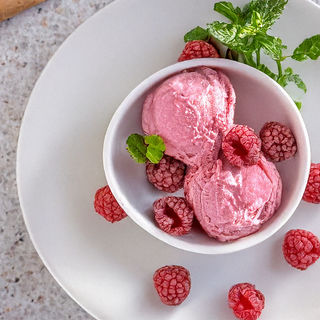- Sear or brown meat on your stovetop, then finish the meal in the slow cooker
- Premium die-cast aluminum cookware heats evenly and cooks directly on gas, electric or ceramic stovetops
- One-pan convenience; one less dish to clean
- Simple programmability with +/- buttons for setting the cooking time and a large dial to select the temperature
- Digital timer lets you know at a glance the remaining cook time
- 6 quart aluminum cookware fits a 6 lb. chicken or a 4 lb. roast
- The glass lid is dishwasher safe and the insert pan is nonstick so baked-on foods are wiped away easily
- Premium die-cast handles
- Questions are supported by a toll-free call center located in the U.S.
- Backed with a one-year warranty
Simple ProgrammabilityThe Stovetop-Safe Programmable Slow Cooker has simplified controls to make programming easy. Just press the +/- buttons to set the cooking time and turn the dial to select your preferred temperature. As your food cooks, the digital display on the control panel counts down so you can see the remaining time at a glance. When the cooking time is up, the slow cooker automatically switches to WARM. If you forget to turn the slow cooker OFF for any reason, the unit will automatically shut off after 14 hours of total cooking time.
Stovetop Searing
When you take the time to brown meat before slow cooking, the delicious flavor you start on your stovetop will improve the taste and the appearance of your finished meal. While this step is not required, it is something that many recipes recommend. Don’t worry – the Stovetop Programmable Slow Cooker makes it easy. Simply remove the aluminum cookware insert and use it directly on your stove. Because it’s made of premium die-cast aluminum, it heats quickly and evenly. Try it yourself with this beef roast recipe developed by the culinary experts in the Hamilton Beach Test Kitchen. It’s a delicious, one-dish meal that you can share with family and friends:
Beef Roast with Vegetables and Thyme Gravy
- 3–4 lb. (1.34–1.8 kg) bottom round beef roast
- 16 baby white and red potatoes
- 1/2–1 tsp. (2.5–5 ml) salt
- 3 medium carrots, sliced
- 1/2 tsp. (2.5 ml) pepper
- 1/2 cup (125 ml) beef broth
- 2 T (30 ml) extra-virgin olive oil
- 4 sprigs fresh thyme
- 1 large onion, cut in wedges
- 3/4 cup (175 ml) water
- 3 garlic cloves, smashed and peeled
- 1/4 cup (60 ml) all-purpose flour
- 8 baby red potatoes
- 1 T (15 ml) butter, optional
Directions: Season beef roast with salt and pepper. Heat olive oil in stovetop-safe cookware over medium-high heat and brown roast well on all sides. Remove from heat. Remove roast from cookware and set aside. Place onion and garlic in stovetop-safe cookware and brown lightly with residual heat from stovetop-safe cookware. Place roast on top of onion and garlic in stovetop-safe cookware. Surround roast with potatoes and carrots. Pour broth over all and top with thyme sprigs. Cover, place stovetop-safe cookware on slow cooker base, and cook on HIGH for 4 hours or LOW for 8 hours.
Remove roast to serving platter. Discard thyme sprigs. Using slotted spoon, remove vegetables to serving platter with roast. Cover with foil to keep warm. Place stovetop-safe cookware back on the stovetop over medium heat and bring pan juices to a boil. Whisk together flour and water. Add to pan juices and simmer, stirring constantly until thickened. Season gravy to taste with salt and pepper. Finish by adding butter, if desired, stirring until melted. Serve gravy with roast and vegetables. Serves: 10 to 12.
SLOW COOKER TIPS
If you’re not familiar with slow cooking, there are a few things you should know about this method of cooking. First, how high you fill the crock (sometimes called the insert pan, stoneware, cookware or vessel) is important. To prevent overcooking, the crock should be filled half-full to no more than one inch from the rim. However, this does not mean to fill the crock with liquid. If cooking soups or stews, leave a 2-inch (5 cm) space between the top of the crock and the food so the recipe can come to a simmer. Secondly, if you lift the lid during cooking, your cooking time will increase due to heat loss. Unless your recipe specifically calls for stirring, resist lifting the lid. Last but not least, if you want to store leftovers after cooking, do NOT place the entire crock in the refrigerator since contents will take too long to cool. Instead, divide leftovers into smaller containers and place in the refrigerator.
Cooking Meat A slow cooker is great for foods that are not naturally tender, such as meat with a lot of connective tissue. These are the least-expensive cuts but also the most flavorful. Like braising, slow cookers tenderize meat slowly as it cooks. If you choose cuts such as chuck roast, pork butt, short ribs or chicken thighs, you won’t be disappointed with the results. If fat is an issue, refrigerate the contents after cooking and skim off the extra fat before serving. Note: you must thaw frozen meat and poultry before adding it to the slow cooker.
Cooking Side Dishes or Dessert Main courses, soups and “one-pot” meals are not the only things that slow cookers are great for preparing. They are also perfect for making side dishes and dessert, especially when your main oven is full. Check out the recipes found at www.HamiltonBeach.com that were developed and tested by the culinary experts in the Hamilton Beach Test Kitchen.
How to Adapt RecipesYou can convert your favorite recipes to slow cooker recipes if you learn these important differences first:
- Liquids do not evaporate in a slow cooker. So unless you are cooking rice, pasta, or beans, reduce amount of liquid to 1/2 of the amount called for in your recipe.
- Fresh vegetables produce the most desirable results. Potatoes, carrots, onions and garlic should be washed and cut in uniform pieces, then placed in the bottom of the crock. Canned and frozen vegetables take less time to cook and can produce overcooked dishes.
- Ground beef should be browned and drained before slow cooking to remove grease.
- Tender foods such as pasta, asparagus and snow peas should be added in the last hour of cooking.
- Dairy products such as cheese, milk, and sour cream should be added in the last half hour of cooking.
- Seafood such as shrimp, scallops, and fish should be added in the last 15-30 minutes of cooking.
Time Conversion ChartFill your slow cooker at least 2/3 full and use this chart to adapt your recipes:
|
Conventional
Recipe Time
|
Slow Cooker Time
on High
|
Slow Cooker Time
on Low
|
|
30 minutes
|
1-1/2 to 2 hours
|
3 to 4 hours
|
|
1 to 2 hours
|
4 to 5 hours
|
8 to 9 hours
|
CARE AND CLEANING
Do not use metal utensils, abrasive cleansers or metal scouring pads on the aluminum insert pan. The glass lid is dishwasher safe. However, as with most aluminum pans and cookware, hand washing is recommended for the aluminum pan. To clean the base, simply wipe it down with a damp cloth. Do not immerse the cord, plug or base in any liquid.











